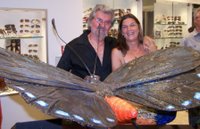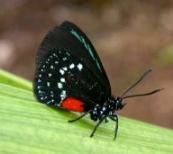The Countdown....
The Count Down…for Hurricane Season…and for Butterfly Tallies
Well, it’s been a while since I’ve had time to write about my favorite butterfly! We haven’t yet fully recovered from Hurricane Wilma, and the season will be upon us again all too soon.
Most of the butterflies have bounced back from last years’ storms and the populations are soaring high again. Some species were hit especially hard, however, such as our State Butterfly, the Zebra Longwing. Dr William Kern at the University of Florida surmises that the reason is because of their delightful roosting habits; while all of the Zebras gathered in what should have been the safety of the branches of their favorite trees, Wilma blew them out of the trees and across oblivion instead. They have taken a long time to recover. Thanks to Mike Tompkins for the photo of roosting Zebra Longwings.
 I had to re-introduce atalas to many of the previously established colonies after Wilma, too. Now, atalas are just beginning to irrupt (increase numbers), and in another few weeks they will be eating all of that fresh spring coontie growth to the ground! Then they may crash until the next irruption. Now that my report to the National Fish and Wildlife Foundation is in their hands, I’ll be sharing more of the exciting news I have learned about them in the past three years. I just released another 200+ to Everglades National Park, and will be continuing to establish private sites as well as natural areas.
I had to re-introduce atalas to many of the previously established colonies after Wilma, too. Now, atalas are just beginning to irrupt (increase numbers), and in another few weeks they will be eating all of that fresh spring coontie growth to the ground! Then they may crash until the next irruption. Now that my report to the National Fish and Wildlife Foundation is in their hands, I’ll be sharing more of the exciting news I have learned about them in the past three years. I just released another 200+ to Everglades National Park, and will be continuing to establish private sites as well as natural areas.
In the meantime, some of the atala butterfly aficionados have prepared for the season by purchasing cages for their charges(I like the Fresh-Aire reptile cages best of any I have seen or tried, shown below) and flower water tubes (from floral supply houses--to help keep the coontie or nectar sources alive), should the weather ask that we bring the babies indoors for a day or two! I even got a test-tube holder from BioQuip to hold the water tubes for the coontie leaves and flowers! This year I’ll be better prepared to harbor the insects through a storm than ever before.

A friendly reminder to all: the Summer Butterfly Count will be occurring in June and July, throughout Florida. Your participation is greatly appreciated! Go to the NABA website (www.NABA.org) and read about the count sites to find an area near you. The count is based on the same concepts that the National Audubon Society established over one hundred years ago to help monitor bird populations!
Butterflies, like birds, are an “indicator species”…they give us a clear indication of the state of our environment, which of course, comes back to our own health and safety. Counting the populations of butterflies lets us know how a particular species is faring in its own right, too. It is also a great way to get to know the species in the best way possible: in the field!
And, lastly, it is a fun day spent with friends who also care about the environment. And of course, how could we truly appreciate nature without the sheer beauty of this delicate insect in it?
On another note, I had the pleasure of meeting a Miami metal sculptor by the name of Fred Caravetta this month! Check out Fred’s work at http://www.caravetta.com/. This picture is of Fred, the atala and me at a small art exhibit at Merrick Village in Miami this month.

Fred’s beautiful 4-foot rendition of the atala butterfly will be on display at Fairchild Tropical Gardens in time for the annual all-day meeting for the Miami Blue Chapter of the North American Butterfly Association on Sunday, July 30, 2006! I hope you are planning on attending this exciting yearly event; the standard entrance fees apply ($20 for non-members). Fairchild is absolutely beautiful this time of year, there will be many butterflies, and author Jeff Glassberg will be the keynote speaker. How cool is that!
Well, it’s been a while since I’ve had time to write about my favorite butterfly! We haven’t yet fully recovered from Hurricane Wilma, and the season will be upon us again all too soon.
Most of the butterflies have bounced back from last years’ storms and the populations are soaring high again. Some species were hit especially hard, however, such as our State Butterfly, the Zebra Longwing. Dr William Kern at the University of Florida surmises that the reason is because of their delightful roosting habits; while all of the Zebras gathered in what should have been the safety of the branches of their favorite trees, Wilma blew them out of the trees and across oblivion instead. They have taken a long time to recover. Thanks to Mike Tompkins for the photo of roosting Zebra Longwings.
 I had to re-introduce atalas to many of the previously established colonies after Wilma, too. Now, atalas are just beginning to irrupt (increase numbers), and in another few weeks they will be eating all of that fresh spring coontie growth to the ground! Then they may crash until the next irruption. Now that my report to the National Fish and Wildlife Foundation is in their hands, I’ll be sharing more of the exciting news I have learned about them in the past three years. I just released another 200+ to Everglades National Park, and will be continuing to establish private sites as well as natural areas.
I had to re-introduce atalas to many of the previously established colonies after Wilma, too. Now, atalas are just beginning to irrupt (increase numbers), and in another few weeks they will be eating all of that fresh spring coontie growth to the ground! Then they may crash until the next irruption. Now that my report to the National Fish and Wildlife Foundation is in their hands, I’ll be sharing more of the exciting news I have learned about them in the past three years. I just released another 200+ to Everglades National Park, and will be continuing to establish private sites as well as natural areas.In the meantime, some of the atala butterfly aficionados have prepared for the season by purchasing cages for their charges(I like the Fresh-Aire reptile cages best of any I have seen or tried, shown below) and flower water tubes (from floral supply houses--to help keep the coontie or nectar sources alive), should the weather ask that we bring the babies indoors for a day or two! I even got a test-tube holder from BioQuip to hold the water tubes for the coontie leaves and flowers! This year I’ll be better prepared to harbor the insects through a storm than ever before.

A friendly reminder to all: the Summer Butterfly Count will be occurring in June and July, throughout Florida. Your participation is greatly appreciated! Go to the NABA website (www.NABA.org) and read about the count sites to find an area near you. The count is based on the same concepts that the National Audubon Society established over one hundred years ago to help monitor bird populations!
Butterflies, like birds, are an “indicator species”…they give us a clear indication of the state of our environment, which of course, comes back to our own health and safety. Counting the populations of butterflies lets us know how a particular species is faring in its own right, too. It is also a great way to get to know the species in the best way possible: in the field!
And, lastly, it is a fun day spent with friends who also care about the environment. And of course, how could we truly appreciate nature without the sheer beauty of this delicate insect in it?
On another note, I had the pleasure of meeting a Miami metal sculptor by the name of Fred Caravetta this month! Check out Fred’s work at http://www.caravetta.com/. This picture is of Fred, the atala and me at a small art exhibit at Merrick Village in Miami this month.

Fred’s beautiful 4-foot rendition of the atala butterfly will be on display at Fairchild Tropical Gardens in time for the annual all-day meeting for the Miami Blue Chapter of the North American Butterfly Association on Sunday, July 30, 2006! I hope you are planning on attending this exciting yearly event; the standard entrance fees apply ($20 for non-members). Fairchild is absolutely beautiful this time of year, there will be many butterflies, and author Jeff Glassberg will be the keynote speaker. How cool is that!


1 Comments:
Just found your site in my favorites list! It's nice to see that you are posting and that you are still keeping busy. Atalas are alive and well in Crandon. Talk to you soon.
Post a Comment
<< Home